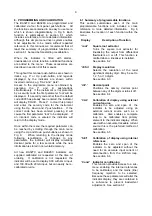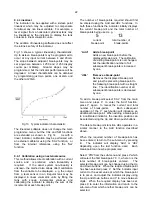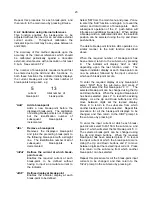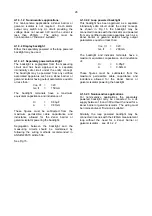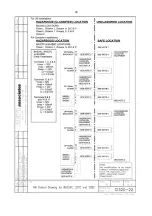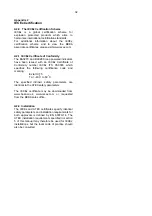
22
9.4 Lineariser
The indicator can be supplied with a sixteen point
lineariser which may be adjusted to compensate
for almost any non linear variable. For example, a
level signal from a horizontal cylindrical tank may
be linearised by the indicator to display the tank
contents in linear volumetric units.
The addition of linearising software does not affect
the intrinsic safety of the indicator.
Fig 13 shows a typical linearising characteristic.
Up to sixteen break-points may be programmed to
occur at any input current between 4 and 20mA.
The slope between adjacent break-points may be
set anywhere between -1250 and +1250 display
counts per milliamp. Greater slopes may be
programmed, but the indicator performance will be
degraded. A linear characteristic can be obtained
by programming just two points, one at 4mA and
the other at 20mA.
Fig 13 Typical indicator characteristic
The lineariser software does not change the main
programme menu, but the CAL and SEt functions
are extended as shown in Fig 14. As with a
linear indicator, calibration may be performed with
an external calibrator using the 'CAL' function, or
from the internal references using the 'Set'
function.
9.4.1 Calibration using an external source
This method allows direct calibration with a current
source, and is preferred when traceability is
required. If the exact system non-linearity is
unknown, the method also allows direct calibration
from the variable to be displayed. e.g. the output
from a level sensor in an irregular tank may be
displayed in linear volumetric units by filling the
tank with known incremental volumes and
calibrating the indicator to display the sum of the
increments at each break-point.
The number of break-points required should first
be entered using the Add and dEL functions. In
both these functions the indicator initially displays
the current break-point and the total number of
break-points being used. e.g.
5 13
current total number of
break-point break-points
'Add'
Add a break-point
Adds a new break-point before the
displayed break-point. The calibration
of existing break-points is not changed,
but the identification number of all
subsequent break-points is increased
by one.
'dEL'
'Remove a break-point
Removes the displayed break-point
and joins the preceding break-point to
the following break-point with a straight
line. The identification number of all
subsequent break-points is decreased
by one.
To add a break-point select 'CAL' from the main
menu and press P to enter the 'Add' function;
press P again to reveal the current and total
number of break-points. Each subsequent
operation of the P push-button will introduce an
additional break-point. When adding a break-point
to a calibrated indicator, the insertion position can
be selected using the Up and Down push-buttons.
The delete break-point function dEL operates in a
similar manner to the Add function described
above.
When the required number of break-points has
been entered, return to the sub-menu by pressing
E. The indicator will display 'Add' or 'dEL'
depending upon the last function used. Each
break-point can now be programmed
Select 'PtS' from the sub-menu and press P which
will select the first break-point '0 n', where n is the
total number of break-points entered. The
selected break-point can be changed using the Up
and Down buttons. When the required break-point
has been selected press P. Set the indicator input
current to the exact value at which the break-point
is to occur, and adjust the indicator display using
the Up and Down buttons and P to move between
digits. When the required display has been set,
press E to enter the information and return to the
sub-menu from which another break-point can be
selected.


